Date: 2025-10-14
Let me share what we've learned about flex PCB endurance testing through years of product validation. The 180-degree bend test is where we separate robust designs from potential field failures, and getting the resistance change threshold right makes all the difference.
Practical Threshold Guidelines Based on Real Applications
Through extensive testing across multiple product categories, we've established these reliable thresholds:
For medical and automotive applications, we maintain a strict 5% maximum resistance change. I remember a cardiac monitor project where we initially used a 10% threshold - during extended testing, we discovered that 7-8% resistance increases correlated with microscopic cracks that would eventually lead to failure. Tightening to 5% caught these marginal boards early.
In industrial equipment, we allow up to 10% resistance variation. This balanced approach has served us well in applications like robotic cabling and factory automation sensors. We found that boards staying within this 10% window consistently survived their intended service life, while those exceeding it often failed within months of deployment.
For consumer products, we typically use a 15% threshold. However, we've learned to be careful here - we once approved a smartwatch strap design that stayed within 15% during testing, but field returns revealed issues. Now we combine resistance monitoring with visual inspection for any consumer product destined for daily flexing.
Understanding What the Numbers Actually Mean
The resistance changes we measure tell a specific story about what's happening inside the board:
When we see gradual increases of 2-8%, we're typically observing copper work hardening and the initial stages of micro-cracking. This is often manageable depending on the application's required lifespan.
Sharp jumps of 10% or more usually indicate more serious issues - either significant crack propagation or delamination starting between layers. In our experience, once a board hits 15% resistance increase, complete trace separation is often imminent.
Key Factors That Influence Your Specific Threshold
We've identified several design elements that significantly impact how we set our thresholds:
Copper thickness dramatically affects performance. Thin copper (18μm) actually outperforms thick copper (70μm) in dynamic flex applications. We learned this while testing automotive harnesses - the thinner copper's flexibility resulted in more consistent resistance readings over thousands of cycles.
Trace geometry matters more than many designers realize. We consistently see that 0.1mm traces need more lenient thresholds than 0.2mm traces. The narrower traces simply have less copper to carry current when micro-cracks begin forming.
Bending radius is crucial. When we test at 0.5mm radius versus 1.0mm, the resistance changes can be 3-4% higher for the same number of cycles. This is why we always match our test radius to the product's actual use case.
Testing Methodology That Delivers Reliable Results
We've refined our approach through plenty of trial and error:
Environmental control is non-negotiable. Temperature variations alone can cause 1-2% resistance fluctuations that have nothing to do with actual damage. We now test in a controlled 23°C environment with stable humidity.
Continuous monitoring beats endpoint testing. By tracking resistance every 50-100 cycles, we can identify problematic boards long before they hit failure thresholds. This approach helped us catch a material compatibility issue in a recent medical probe project.
Automated test equipment eliminates human variability. Early in my career, I saw how manual bending introduced inconsistent stress patterns. Our motorized testers now apply exactly the same bend profile every time.
The Reality Check
Setting appropriate resistance change thresholds requires understanding both your electrical requirements and mechanical environment. The 5-15% range provides a solid starting point, but the most successful test programs consider the specific product context rather than blindly applying standards.
What matters most is correlating your test results with actual field performance - that's how you develop the intuition to distinguish between acceptable variation and impending failure.
related link:
Capel manufacturing PCBs since 2009. Professional technology and high-precision Printed Circuit Boards involved in Medical, IOT, UAV, Aviation, Automotive, Aerospace, Industrial Control, Artificial Intelligence, Consumer Electronics etc..